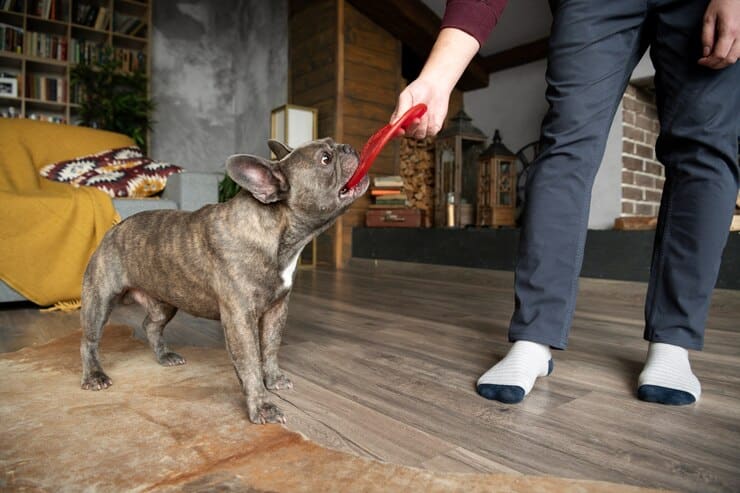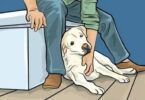The Effect of Pain on Dog Behavior: Understanding the Connection
Dog behavior is one of the most fascinating and complex aspects of pet ownership. As dog owners, we often spend time analyzing, interpreting, and addressing various behaviors in our pets, from simple quirks to more complex issues like anxiety, aggression, or destructiveness. While some of these behaviors may seem to stem from behavioral or environmental factors, there is one significant aspect often overlooked—pain. Pain, whether chronic or acute, can have profound effects on a dog’s behavior, and understanding this connection is crucial for providing the best care possible.
The Hidden Impact of Pain on Dog Behavior
Pain in dogs is often subtle and not immediately visible. Dogs are highly skilled at masking discomfort, a survival trait that dates back to their wild ancestors. This ability to conceal pain means that many pet owners may not recognize when their dog is suffering. However, pain is not just a physical experience—it can lead to significant changes in behavior, and recognizing these behavioral changes is critical.
Pain can arise from a variety of causes, including injury, arthritis, dental issues, gastrointestinal problems, and even emotional stress. When dogs are in pain, they may exhibit behavioral changes such as aggression, increased anxiety, lethargy, or a decrease in normal social interactions. In many cases, what appears to be a behavioral problem may actually be pain-induced, and addressing the underlying pain can lead to dramatic improvements in behavior.
Understanding the Four Main Categories of Pain-Related Dog Behavior
In veterinary behavior studies, especially those conducted by experts like Dr. Daniel Mills, four main categories of pain-related dog behavior have been identified. These categories help to better understand how pain can manifest in different behavioral changes, both obvious and subtle. Let’s explore these categories in more detail.
1. Undesirable Behavior Directly Caused by Pain
The most obvious way pain affects a dog’s behavior is by causing undesirable or abnormal behaviors directly linked to discomfort. Some of the most common signs of pain in dogs include:
- Reluctance to Move: A dog in pain may avoid running, jumping, or climbing stairs. They might also be reluctant to engage in their usual playful activities. This reluctance is often mistaken for laziness or disobedience.
- Changes in Posture: A dog suffering from pain may sit, lie down, or stand in a way that is unusual for them. For example, a dog with hip or back pain may adopt a “frog-like” sitting position, or they may stand with an uneven weight distribution to avoid putting pressure on an injured area.
- Excessive Licking or Biting: Dogs often lick, bite, or scratch areas of their body that are painful. This self-soothing behavior is common, especially when they are dealing with localized pain such as a muscle strain, joint inflammation, or even an injury.
- Vocalizations: Dogs in pain may vocalize more than usual. This can include whining, whimpering, growling, or even yelping when touched. In some cases, this might also indicate behavioral anxiety or fear.
- Restlessness: A dog experiencing pain may constantly shift its weight or change positions to try and find relief. They might pace, appear unable to relax, or demonstrate an inability to settle down.
These behaviors may seem like normal quirks at first glance, but they are often indicative of pain. Identifying these behaviors as potential signs of discomfort can help owners take the necessary steps to address the issue before it becomes more serious.
2. Exacerbation of Pre-Existing Behavioral Problems Due to Pain
For dogs with pre-existing behavioral issues, pain can often make these issues significantly worse. This category is particularly important because it emphasizes how pain interacts with other behavioral problems, complicating treatment and diagnosis. Examples include:
- Increased Anxiety: A dog already suffering from separation anxiety may become more agitated and destructive when they are also in pain. Pain can exacerbate anxiety, causing the dog to react more intensely to triggers, even those they previously tolerated well.
- Aggression: Dogs that are normally calm or gentle may become aggressive when they are in pain. This aggression is often defensive, as the dog may feel vulnerable and is trying to protect itself from further harm. It’s not uncommon for a dog with pain to snap at or growl at its owners or other pets in the household when touched, especially if they are in a sensitive area.
- Destruction or Obsessive Behavior: A dog experiencing pain may engage in destructive behaviors, like chewing or digging, as a way to cope with discomfort. For example, a dog with dental issues might start chewing excessively on furniture or items around the house as a way of trying to relieve the pain in their mouth.
- Withdrawal or Avoidance: Pain can make a dog more withdrawn or less social. Dogs in pain may avoid their owners, refuse affection, or isolate themselves from family members and other pets. This can be particularly concerning for owners who are unaware of the pain, interpreting the behavior as a sign of behavioral issues rather than a physical problem.
Recognizing the exacerbating role pain plays in these behaviors is key to understanding and managing these issues effectively.
3. Pain-Induced Aggression
Aggression is one of the most significant behavioral changes that can occur when a dog is in pain. This form of aggression is often triggered by the dog’s need to protect itself from further discomfort. The most common triggers for pain-induced aggression include:
- Touch: A dog in pain may lash out when touched in a specific area, especially if it’s sensitive or injured. This can happen when a dog is approached from behind or when they are lying down and startled.
- Increased Sensitivity to Handling: Even dogs that are normally tolerant of handling may suddenly become aggressive when in pain. They may growl, snap, or even bite if touched unexpectedly or in a way that exacerbates their discomfort.
- Defensive Aggression: Dogs may become more defensive when they feel threatened or vulnerable. Pain can make a dog feel more insecure, leading to an increase in aggressive behaviors such as growling, barking, or snapping at family members, other pets, or strangers.
Pain-induced aggression can be difficult to manage because it often appears suddenly and may be directed at specific triggers, such as when the dog is approached while lying down or when certain areas of their body are touched.
4. Behaviors That Are Not Immediately Recognized as Problematic by Owners
In some cases, dogs may exhibit behaviors that do not immediately seem problematic to owners, but are actually signs of pain. These subtle behaviors can be easy to overlook but should be taken seriously. Some examples include:
- Changes in Activity Levels: A dog that suddenly becomes lethargic or loses interest in activities they once enjoyed may be experiencing pain. This can be difficult to identify because many owners simply think the dog is “slowing down with age.”
- Posture or Movement Changes: Subtle changes in how a dog sits, stands, or moves can indicate pain, particularly if the dog is compensating for discomfort in their limbs or back. A dog that appears stiff or reluctant to move may be experiencing arthritis or musculoskeletal pain.
- Changes in Appetite or Eating Habits: Dogs in pain may eat less or show a decreased interest in food. Conversely, some dogs may overeat as a way of self-soothing. Changes in appetite are often linked to gastrointestinal distress or discomfort, which could be a sign of pain.
- Over-attachment or Clinginess: A dog in pain may become more clingy or needy, seeking constant attention and reassurance from their owner. This behavior could be an indication that the dog is trying to comfort itself or alleviate discomfort through emotional support.
These subtle signs are often dismissed as minor behavioral quirks, but they may indicate that the dog is suffering from an underlying health issue that should be addressed.
The Role of Veterinarians in Diagnosing and Treating Pain-Related Behaviors
Veterinarians play a crucial role in identifying and managing pain-related behaviors in dogs. However, diagnosing pain in dogs can be challenging, as pain often presents itself in subtle or indirect ways. Traditional veterinary examinations may not always identify the source of pain, and many cases require a more in-depth analysis.
Dr. Daniel Mills emphasizes the importance of considering pain as a potential factor when addressing behavioral problems in dogs. In many cases, behavior changes are the result of an unrecognized injury, illness, or discomfort. Mills suggests that if traditional behavioral interventions are not working, it may be necessary to explore pain management options.
Pain Management and Behavioral Improvement
Once pain is identified as a contributing factor to behavioral issues, the next step is to address it through appropriate pain management. Pain relief options for dogs can include:
- Pain Medications: Nonsteroidal anti-inflammatory drugs (NSAIDs) and other pain relievers can help reduce inflammation and alleviate pain. Veterinarians may prescribe these medications based on the severity and type of pain the dog is experiencing.
- Physical Therapy: For dogs with musculoskeletal issues, physical therapy can help improve mobility and reduce discomfort. Therapies like massage, heat therapy, or acupuncture may also provide relief.
- Surgery or Medical Interventions: In some cases, surgery may be necessary to address underlying issues like fractures, ligament tears, or joint problems.
- Behavioral Therapy: Once pain is managed, behavioral therapy can be used to address any ongoing behavioral problems. This might include training, desensitization, or environmental adjustments to help the dog cope with anxiety or aggression.
The Importance of Addressing Pain in Dog Behavior
Understanding the connection between pain and dog behavior is critical for providing the best care for your pet. Pain can manifest in various ways, from subtle changes in activity level to more dramatic behavioral shifts like aggression and anxiety. By recognizing the signs of pain and working closely with your veterinarian to manage it, you can improve your dog’s quality of life and address the behavioral issues that arise as a result of discomfort.
If your dog is exhibiting behavioral changes that seem out of character, it’s essential to consider the possibility of pain and seek professional guidance. Treating pain should be the first step in addressing behavioral problems, as doing so can lead to significant improvements in your dog’s behavior, health, and overall well-being.










